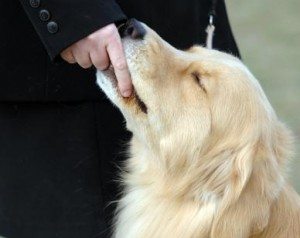I have two pitbulls who love each other very much. However, randomly when people walk in to the house my little guy gets very anxious and my female takes his behavior as being aggressive and we have some major fights. The dogs need to be pulled apart otherwise they would literally kill each other. This Friday was the latest and I ended up having to bring my dog to emergency for two major gashes on his leg which required 6 stitches each as well there is a chunk missing from his ear that has another 5 stitches. The dogs don’t realize they are fighting each other cause once we split them up they always run to the dog bed together and huddle because they think they are in trouble.
They are really well behaved with people and have never ever shown any aggression towards anyone who walks in to my house. It only happens when guests come over but the fights are getting worse and are happening much more often. Any advice you can provide would be so helpful.
Thanks,
Jaime
Hi Jaime,
Yikes, it sounds like things are more than just a bit hectic at your house! It sounds like things are getting, if they aren’t already, quite dangerous. From what I’m reading, I am hearing that your male gets anxious and then your female interprets his behavior as being aggressive. Since I haven’t actually witnessed either of them, or seen a video of them, it makes it more difficult for me to determine what is really going on. In situations like this, I find it much more helpful if we don’t use adjectives to describe the dogs, but rather, report the actual behaviors that are taking place.
This makes it much easier for me to determine what is actually going on. Hearing that a dog tucks his tail between his legs, whimpers, and engages in a lot of tongue flicking, head turning and blinking tells that the dog is fearful and/or anxious….much more so than just hearing someone tell me he is. Do you see what I mean? I am not saying that your male is not anxious, he very well probably is, but describing actual behavior tells me much, much more.
When it comes to multi dog households, most people imagine, or want a scene where the two (or more) dogs are the best of friends. That they share everything and live together harmoniously. As you can attest to, this is not always the case. Not all dogs like being with other dogs, and some dogs get along very well most of the time, except when it comes to dinner, or some other stressful situation.

When there are skirmishes, they often revolve around resources, and how the dogs might not be as into sharing them as we might want them to be. Food, favorite sleeping spots, beds, toys, even access to people, and/or their owners can all become things that each dog may want preferred access to. It doesn’t sound as if your dogs are resource guarding, but it does sound like when guests come to the home, that this is the trigger for the fights. Either way, I often suggest that multi dog households have two of most things for their dogs. Two food bowls, two beds, each their own toys, or enough to go around at least.
When it comes to aggression between dogs who live together, the aggression can be rooted in fear, in over arousal, in pain, or in stress. Some dogs who become fearful then become aggressive, as a way to deal with their fear. With over arousal, this occurs with dogs who get too excited, too amped up, and don’t know how to bring themselves back down to lower levels of excitement. They play, and they play, and the playing escalates in intensity. Aggression results when one of, or both dogs ‘tip over’. It can also occur with a dog who is overly aroused when greeting dogs, or who has poor canine manners. Aggression between dogs who live together can also result from stress and/or tension. Often times there is tension between the dogs that might not seem to be a problem, and can be triggered by more than one thing.
In the meantime, it is important to try and prevent more of these fights from occurring between the dogs. The more they do it, the more stressful the dogs will become, The more they engage in the unwanted behavior (fighting), they better at it they’ll get. It will also become harder to stop them once they do start fighting. The more a dog is reinforced for a behavior, the more the dog will offer this behavior in the future. We need to try to prevent this, before someone gets seriously hurt.
I would highly suggest a visit to a vet, preferably a veterinary behaviorist, for full bloodwork, to rule out anything medical that can be adding to the stress. If there is something medical that can be treated, it’s best to know about it and treat it. Dogs are excellent at hiding their pain, and many times we don’t even know that our dogs are unwell, or hurt.
I would also highly advise managing the dogs so that when people do come over, that the two dogs are not together at the door, greeting your guests. I would suggest separating them when people come over, to prevent any more fights, until you are able to determine what is going on, with the help of a qualified professional who will implement some behavior modification.
The thing is, we have to determine what the dogs are actually doing, and why. Each of the two dogs has a trigger that sets each of them off. And they both are not triggered by the same thing. One might be triggered by guests coming into the home, while the other is triggered by the first dog’s behavior. They may also be triggered by other things.
I would advise first learning what stresses each dog, and once you do, then you’ll be able to lower the levels of stressors for each dog. This will help in the overall tension between the two. Think of each and every little thing that may stress each of the dogs. The easier we can make things between them, the better.
Things that can help reduce tension in dogs is neutering and/or spaying the dogs. The quality of food can have an impact on behavior as well, so I often advise people to feed the best that they can afford. Stimulation is also very important. Physical as well as mental. Daily walks, together or separate, depending on how they

are together are essential. As are activities that engage their minds. Something as simple as feeding them their meals in a Kong, where they have to think and work to get their food, is a marvelous stress reducer. There is no rule anywhere that our dogs need to be fed from a bowl that we put on the floor.
I would also highly advise everyone not to correct the dogs at all. You will need to interrupt any fight, of course, but we should refrain from correcting either of the two. We cannot chastise a dog for feeling a certain way, but we can change how they feel about something, which will in turn change their behavior. While corrections can sometimes suppress a behavior, as in make the dog stop doing what it was doing for the moment, corrections do nothing to help the dog learn how to deal with the situation, or feelings that got him there in the first place.
They don’t teach a dog what it should do instead, which is why when we yell at our dogs for barking at the door, they may stop barking that time, but the next time someone passes by, they’ll revert back to their barking. Correcting a behavior often also just leaves a behavioral vacuum. And it often reinforces the negative feelings the dogs have, as they are associating the corrections with the negative behavior, and each other. Something we don’t want to do.
What we can do is teach the dogs an acceptable alternate behavior. Instead of letting them react in a certain manner when guests come to the door, we can teach them something else to do, such as going to their own mats, which they will get rewarded for. If the reward for the new wanted behavior is rewarded enough, with something that is of higher value than what the dog gains from the naughty behavior, then the dog will offer that new behavior more often.
Dogs will always do what pays off best for them. So, we need to ensure that what we’re asking of them pays off more to them than engaging in the naughty behavior.
Each dog will also need to be worked with in accordance to what their own triggers are. We can do this by changing their emotional states regarding their triggers. To do so, we’d use counter conditioning and desensitization. We’d pair up things the dog loves with the trigger, always keeping the dog far enough away so that he

doesn’t react negatively (keeping the dog below threshold), so that the dog starts to make positive associations with the trigger. If we pair up something the dog is scared of with something the dog loves, such as fried hot dog slices, while keeping him under threshold, the dog will start to associate the trigger with something wonderful, which will change his mind about that trigger. We do need to keep in mind though, that whatever we are using to change the dog’s emotional response to the trigger needs to be used only in the presence of the trigger. So if you are using fried liver, you can only use the fried liver when working with the trigger, and you will not be able to give the dog any fried liver at any other time.
In conjunction with what I’ve advised, I will again recommend managing the dog’s environment and their access to the stressors, especially for the time being. I understand that management isn’t always easy, and can sometimes be difficult to adhere to. Not everyone can live with baby gates all through the house. Not everyone can deal with the stress that the managing brings.
Not everyone can start living a reclusive life, with no more guests coming over. Which is why it is why I suggest you contact a qualified positive reinforcement professional who can help you.
Meira Frankl
 Montreal Dog Blog Montreal's Online Dog Park
Montreal Dog Blog Montreal's Online Dog Park




